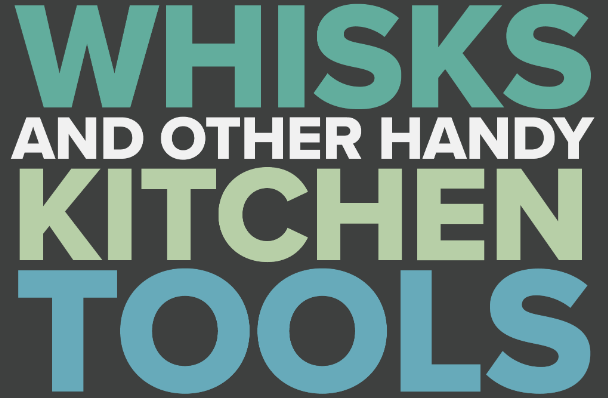Cooking Through the Ages: A Historical and Technological Tour of Kitchen Tools

Table of Contents
Surprising origins of common kitchen utensils
Kitchen utensils are vital to human civilization and have a rich history spanning centuries. Join us on a journey through time as we uncover the intriguing stories behind these kitchen must-haves.
One of the oldest and most essential kitchen utensils, knives have been in use since prehistoric times. Early knives were made of stone, but as technology advanced, they were made of metal.
Spoons
They have been used since ancient times and were typically made of wood or bone. The Romans were the first to make spoons from metal, and over time, spoons became more decorative and ornate.
Forks
They were not commonly used until the Middle Ages, when they were used by the wealthy as a dining utensil. Forks as we know them today, with multiple tines, were developed in the 18th century.
Ladles
Ladles have been used for serving soup and other liquids for thousands of years. Early ladles were made of wood or bone, while modern ladles are typically made of metal or plastic.
Tongs
Tongs have been in use for centuries and were originally used for grabbing hot coals from a fire. Over time, tongs were developed for use in cooking and serving food.
Whisks
Whisks have been used for centuries to beat eggs, cream, and other ingredients. Early whisks were made of twigs or bundles of grass, while modern whisks are made of metal or plastic.
Rolling pins
Rolling pins have been in use since ancient times, and were originally made of stone or wood. Over time, they were developed for use in baking and pastry-making.
Used for grinding spices and other ingredients, mortars and pestles have been in use for thousands of years. They were originally made of stone, but modern versions can be made of various materials, including metal and ceramic.
Graters
Graters of all varieties have been used for centuries to grate cheese, vegetables, and other ingredients. Early graters were made of wood, while modern graters are typically made of metal or plastic.
Strainers
Strainers have been in use for thousands of years to separate solids from liquids. Early strainers were made of woven reeds or grass, while modern strainers are typically made of metal or plastic.
The evolution of kitchen tools
From the earliest stone knives to the latest high-tech gadgets, kitchen tools have undergone numerous changes that have improved their functionality and design.
One of the most significant changes in kitchen tools has been the materials used to make them. In the past, utensils were primarily made of natural materials like wood, bone, and stone.
However, with the advent of metalworking, utensils made of metals like copper, brass, and bronze became more common. Today, most kitchen tools are made of stainless steel, which is durable, corrosion-resistant, and easy to clean.
Another notable change in kitchen tools is the design. Over time, utensils have become more specialized, with tools like potato peelers, apple corers, and avocado slicers designed for specific tasks.
The shape of utensils has also changed to be more ergonomic, making them more comfortable to use for extended periods.
Technological advancements have also played a significant role in the evolution of kitchen tools. Kitchen gadgets like electric mixers, blenders, and food processors have made cooking and baking easier and more efficient.
Smart kitchen tools like scales and temperature probes can connect to smartphones or tablets, allowing cooks to monitor their food from afar.
The evolution of kitchen tools is a fascinating topic that showcases the creativity and ingenuity of human beings.
By understanding how kitchen utensils have evolved over time, we can gain a better appreciation of the tools we use daily and how they have been shaped by technology, culture, and innovation.
Cultural significance of kitchen tools
Different cultures have unique cooking methods and styles, which have influenced the design and usage of kitchen tools.
For instance, in Japan, knives are considered sacred objects, and the art of making knives has been passed down through generations. The traditional Japanese knife is made of high-carbon steel and has a sharp edge, making it ideal for slicing sashimi and other delicate foods.
In India, the mortar and pestle are an essential kitchen tool used for grinding spices and herbs. The mortar and pestle are also used in Ayurvedic medicine to prepare herbal remedies.
In Chinese culture, the wok is an iconic cooking tool used for stir-frying, steaming, and deep-frying. The wok’s round-bottomed shape allows for even heat distribution and can be used with a variety of cooking techniques.
In Mexican cuisine, the molcajete is a stone mortar and pestle used for grinding spices, making guacamole, and preparing salsas. The molcajete is often passed down through generations, becoming a treasured family heirloom.
Kitchen tools can also have religious or ceremonial significance. For instance, the Jewish seder plate is a ceremonial plate used during the Passover Seder to hold symbolic foods.
The seder plate typically includes a zeroah (shank bone), maror (bitter herbs), charoset (a mixture of fruits and nuts), karpas (a vegetable), and beitzah (a hard-boiled egg).
The cultural significance of kitchen tools is an intriguing aspect of their history. Understanding the cultural context and significance of these tools can deepen our appreciation of different cuisines and cooking traditions.
It also shows how kitchen tools have been shaped by the beliefs, customs, and practices of different cultures.
Unusual kitchen tools
Unusual kitchen utensils are tools that are not commonly found in a typical kitchen but are used for specific purposes. Here are a few examples of unusual kitchen utensils:
Cherry Pitter
A cherry pitter is a small tool used to remove the pits from cherries, allowing for easier consumption or use in recipes.
Herb Scissors
Herb scissors are a unique type of kitchen scissors with multiple blades that allow for quick and easy cutting of herbs.
Melon Baller
A melon baller is a small tool used to scoop out small, round balls of melon for use in fruit salads or other recipes.
Egg Slicer
An egg slicer is a tool used to slice hard-boiled eggs into even slices for use in salads or other dishes.
Pineapple Corer
A pineapple corer is a tool used to remove the core from a pineapple, making it easier to slice and serve.
Avocado Slicer
An avocado slicer is a tool used to cut, pit, and slice avocados quickly and easily.
Butter Spreader
A butter spreader is a unique tool used to easily spread butter or other spreads onto bread or toast.
While some of these utensils may not be essential in a kitchen, they can be helpful for specific tasks and can make cooking and preparing food more efficient and enjoyable. Plus, they can add a touch of fun and novelty to your kitchen tools collection!
Kitchen tools in literature and pop culture
Kitchen tools have played an important role in literature and pop culture, often used as symbolic objects to represent themes, emotions, or character traits.
Here are a few examples of how kitchen tools have been represented in literature, films, and other forms of media:
The Knife
The knife is a common kitchen tool that has been used as a symbol in literature and films. In William Shakespeare’s play “Macbeth,” the character Lady Macbeth famously urges her husband to use a knife to murder the king.
In the film “Psycho,” the character Norman Bates uses a knife to commit murder, which has become an iconic scene in pop culture.
The Rolling Pin
The rolling pin has been used in literature and films to represent themes of domesticity and femininity. In the film “Julie & Julia,” the character Julie Powell uses a rolling pin to make a pie, which represents her desire to find meaning and fulfillment in her life through cooking.
The Whisk
The whisk has been used in pop culture to represent creativity and innovation. In the film “Ratatouille,” the character Remy the rat uses a whisk to create a unique and innovative dish that ultimately saves the restaurant where he works.
The Ladle
The ladle has been used in literature and films to represent nurturing and caregiving. In the novel “Like Water for Chocolate” by Laura Esquivel, the character Tita uses a ladle to cook meals that are infused with her emotions and love, which have a profound effect on those who eat them.
The Egg Beater
The egg beater has been used in literature and films to represent themes of progress and modernity. In the novel “The Bell Jar” by Sylvia Plath, the character Esther Greenwood uses an egg beater to make a cake, which represents her desire to embrace the modern world and break free from traditional gender roles.
These examples demonstrate how kitchen tools can be used as powerful symbols in literature and pop culture.
Whether used to represent themes of violence, femininity, innovation, nurturing, or progress, kitchen tools have played an important role in shaping the stories we tell and the characters we love.
Kitchen tool innovations
Kitchen tool innovations have transformed the way we cook and prepare food in recent years. Here are a few examples of some of the latest technological advancements in kitchen utensils:
Smart Scales
Smart scales have become popular in recent years and have changed the way we measure ingredients.
These scales are connected to an app on your smartphone and can provide precise measurements of ingredients, as well as track nutritional information and even suggest recipes based on the ingredients you have on hand.
Immersion Blenders
Immersion blenders, also known as hand blenders, have become a popular kitchen tool for their versatility and ease of use.
They are handheld devices with a blending attachment that can be used to puree soups, sauces, and smoothies directly in the pot or container, without the need to transfer the ingredients to a separate blender.
Sous-Vide Machines
Sous-vide machines have revolutionized the way we cook meat and vegetables. Sous-vide cooking involves sealing food in a plastic bag and cooking it in a water bath at a precise temperature, which ensures that the food is cooked evenly and retains its flavor and moisture. Sous-vide machines make this technique easy to use and accessible for home cooks.
Smart Ovens
Smart ovens are equipped with Wi-Fi connectivity and can be controlled through an app on your smartphone. They can perform a range of functions, from baking to grilling to roasting, and can even suggest recipes based on the ingredients you have on hand.
Smart ovens can also be used to preheat the oven, set cooking times and temperatures, and receive notifications when your food is ready.
Air Fryers
Air fryers have become popular for their ability to cook food quickly and with less oil than traditional deep frying. They work by circulating hot air around the food, which crisps and browns it without the need for added oil. Air fryers are versatile and can be used to cook a range of foods, from vegetables to chicken wings to desserts.
These examples demonstrate how technological advancements in kitchen utensils have transformed the way we prepare and cook food.
Smart scales, immersion blenders, sous-vide machines, smart ovens, and air fryers are just a few examples of how innovative kitchen tools have made cooking more accessible, efficient, and enjoyable.
That’s our historical and technological tour of kitchen tools
Kitchen utensils are not just tools we use to prepare and cook food – they have a rich and fascinating history that spans centuries. From prehistoric knives made of stone to modern sous-vide machines, kitchen tools have undergone countless changes and innovations over the years.
By understanding the stories and origins behind these utensils, we can gain a deeper appreciation for the role they play in our daily lives.
While some kitchen utensils have been around for thousands of years, others have emerged only recently thanks to technological advancements.
The latest kitchen innovations, such as smart scales and immersion blenders, have transformed the way we prepare and cook food, making the process faster, more accurate, and more convenient.
As technology continues to evolve, we can expect even more exciting developments in the world of kitchen utensils.
Whether you’re a professional chef or a home cook, it’s hard to overstate the importance of kitchen utensils. These tools not only help us prepare and cook food, but they also connect us to the rich history of culinary traditions that have been passed down through the generations.
By embracing the old and the new, we can continue to explore the vast and fascinating world of kitchen utensils for years to come.
Thanks for reading!
Other Articles
- What are the different types of range hoods?
- 4 Types of Range Hoods to Never Buy! (And Why)
- Determining the Ideal CFM for Your Outdoor Range Hood (From the Pros)
- Does an outdoor kitchen need a vent hood? (From Experts)
- Who to Hire for Flawless Outdoor Range Hood Installation








Comments are closed.